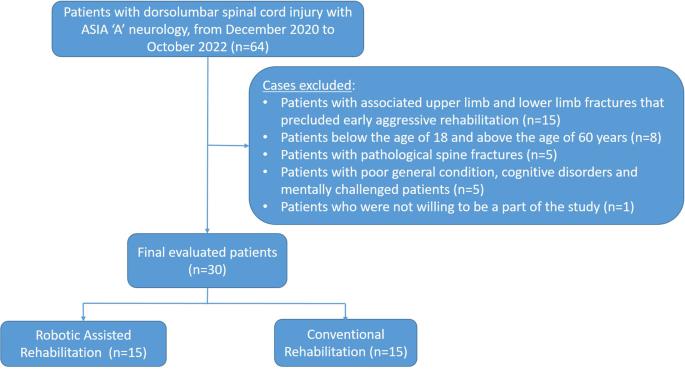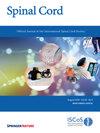Effect on functional outcome of robotic assisted rehabilitation versus conventional rehabilitation in patients with complete spinal cord injury: a prospective comparative study
IF 2.1
4区 医学
Q3 CLINICAL NEUROLOGY
引用次数: 0
Abstract
Prospective Comparative Study. This study aims to compare the functional outcomes of Robotic-assisted rehabilitation by Lokomat system Vs. Conventional rehabilitation in participants with Dorsolumbar complete spinal cord injury (SCI). University level teaching hospital in a hilly state of northern India. 15 participants with Dorsolumbar SCI with ASIA A neurology were allocated to robotic rehabilitation and 15 participants to conventional rehabilitation after an operative procedure. Pre-and Post-rehabilitation parameters were noted in terms of ASIA Neurology, Motor and sensory function scores, WISCI II score (Walking Index in SCI score), LEMS (Lower Extremity Motor Score), SCI M III score (Spinal Cord Independence Measure III score), AO Spine PROST (AO Patient Reported Outcome Spine Trauma), McGill QOL score (Mc Gill Quality of Life score), VAS score (Visual Analogue Scale) for pain and Modified Ashworth scale for spasticity in lower limbs. On comparing robotic group with conventional group there was a statistically significant improvement in Robotic-assisted rehabilitation group in terms of Motor score (p = 0.034), WISCI II score (p = 0.0001), SCIM III score (p = 0.0001), AO PROST score (p = 0.0001), Mc GILL QOL score (p = 0.0001), Max velocity (p = 0.0001) and Step length (p = 0.0001). Whereas LEMS score (p = 0.052), ASIA neurology (p = 0.264 (ASIA A); 1.000 (ASIA B); 0.053 (ASIA C)), VAS score (p = 0.099), Sensory score (p = 0.422) and Modified Ashworth scale for spasticity (p = 0.136) were not statically significant when comparing between two groups. Robot-assisted rehabilitation is superior than conventional rehabilitation in people living with SCI with AIS A neurology. Differences in the patient group, type of a lesion its and severity, duration from onset to initiation of rehabilitation, devices employed, administration of the therapies and regulation of interventions are likely the cause of variations in the findings seen in the literature for robotic assisted training. Level of Evidence: III.


机器人辅助康复与传统康复对完全性脊髓损伤患者功能预后的影响:一项前瞻性比较研究。
研究设计前瞻性比较研究:本研究旨在对背腰部完全性脊髓损伤(SCI)患者使用 Lokomat 系统进行机器人辅助康复治疗与传统康复治疗的功能效果进行比较:方法:15 名患有背腰部 SCI 的 ASIA A 级神经病患者在手术后被分配接受机器人康复治疗,15 名患者接受传统康复治疗。康复前后的参数包括:ASIA神经学、运动和感觉功能评分、WISCI II评分(SCI步行指数评分)、LEMS(下肢运动评分)、SCI M III评分(脊髓独立性测量III评分)、AO脊柱PROST(AO脊柱创伤患者报告结果)、McGill QOL评分(Mc Gill生活质量评分)、疼痛VAS评分(视觉模拟量表)和下肢痉挛改良Ashworth量表。结果:机器人组与传统组相比,机器人辅助康复组在运动评分(p = 0.034)、WISCI II 评分(p = 0.0001)、SCIM III 评分(p = 0.0001)、AO PROST 评分(p = 0.0001)、Mc Gill QOL 评分(p = 0.0001)、最大速度(p = 0.0001)和步长(p = 0.0001)方面均有显著改善。而 LEMS 评分(p = 0.052)、ASIA 神经评分(p = 0.264 (ASIA A);1.000 (ASIA B);0.053 (ASIA C))、VAS 评分(p = 0.099)、感觉评分(p = 0.422)和改良阿什沃斯痉挛量表(p = 0.136)在两组间比较无统计学意义:结论:对于神经内科AIS A级SCI患者,机器人辅助康复优于传统康复。患者群体、病变类型及其严重程度、从发病到开始康复的持续时间、所使用的设备、治疗方法的管理和干预措施的调节等方面的差异,很可能是导致机器人辅助训练的文献研究结果存在差异的原因:证据等级:III.
本文章由计算机程序翻译,如有差异,请以英文原文为准。
求助全文
约1分钟内获得全文
求助全文
来源期刊

Spinal cord
医学-临床神经学
CiteScore
4.50
自引率
9.10%
发文量
142
审稿时长
2 months
期刊介绍:
Spinal Cord is a specialised, international journal that has been publishing spinal cord related manuscripts since 1963. It appears monthly, online and in print, and accepts contributions on spinal cord anatomy, physiology, management of injury and disease, and the quality of life and life circumstances of people with a spinal cord injury. Spinal Cord is multi-disciplinary and publishes contributions across the entire spectrum of research ranging from basic science to applied clinical research. It focuses on high quality original research, systematic reviews and narrative reviews.
Spinal Cord''s sister journal Spinal Cord Series and Cases: Clinical Management in Spinal Cord Disorders publishes high quality case reports, small case series, pilot and retrospective studies perspectives, Pulse survey articles, Point-couterpoint articles, correspondences and book reviews. It specialises in material that addresses all aspects of life for persons with spinal cord injuries or disorders. For more information, please see the aims and scope of Spinal Cord Series and Cases.
 求助内容:
求助内容: 应助结果提醒方式:
应助结果提醒方式:


